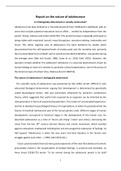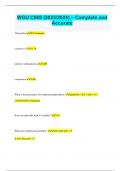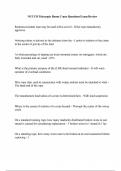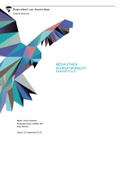Report on the nature of adolescence
Is it biologically determined or socially constructed?
Adolescence has been defined as a ‘transitional period from childhood to adulthood, with an
onset that includes pubertal maturation and an offset … marked by independence from the
parent’ (Casey, Duhoux and Cohen 2010:749). This period has been repeatedly portrayed as
being ridden with emotional turmoil, mood disruptions, sensation-seeking, irrationality and
stress. This rather negative view of adolescence has been bolstered by studies which
documented that the self-reported levels of anxiety peak and the mortality rate -primarily
due to preventable forms of death such as suicide and accidental fatalities- rises greatly during
the teenage years (Abe and Suzuki, 1986; Casey et al., 2010; Dahl, 2001). However, the
question remains whether this adolescent turbulence is a universal phenomenon driven by
human biology or more of a reaction to particular cultural expectations; ‘one of the prices of
the American type of culture’ (Hsu, Watrous & Lord 1960:52).
The nature of adolescence is biologically determined
The scientific study of adolescence was pioneered by Hall (1904, Arnett 1999:317), who
advocated biological determinism arguing that development is determined by genetically
coded physiological factors. Hall was particularly influenced by Lamarck’s evolutionary
theory, which suggested that useful traits acquired by an organism can be inherited by the
next generation in forms of acquired characteristics. This notion of ‘accumulated experience’
led him to develop his psychological theory of recapitulation, in which he postulated that the
history of mankind had become part of the human genetic code. Different stages of human
development correspond to historical stages in the development of the human race. He
described adolescence as a time of ‘Sturm and Drang’ (‘storm and stress’), borrowing the
name from the late 18th century German literary and artistic movement, which revolted
against rationalism, emphasized individualism and encouraged the expression of feelings. As
Hall argued: ‘Adolescence is when the very worst and best impulses in the human soul
struggle against each other…’ (1904, Dahl 2016:101).
Classic psychoanalytic theorists were great proponents of the view that adolescent turmoil,
presumably rooted in the recapitulation of Oedipal feelings, is universal and inevitable. As
Anna Freud (1958:275) wrote: ‘To be normal during the adolescent period is by itself
1
, abnormal’. The psychic reorganization caused by the increase of hormones and sexual
instincts is believed to prompt psychic instability, irritability, argumentativeness and
aggressiveness (Buchanan, Eccles and Becker 1992:63). However, more modern
psychoanalytic models argue that although adolescence tends to be a period of psychic
instability, those with a healthy ego can negotiate these changes effectively.
Several neurobiological hypotheses, most concerning brain development, have been
proposed for why adolescence might be a period of heightened recklessness. The
maturational imbalance theory, also known as the dual models system, argues that the
increase in risk-taking behaviour in adolescence can be attributed to asynchronous
development in the brain’s ‘socio-emotional’ incentive-processing system and the cognitive
control system (Harden and Mann, 2015; Steinberg and Chein, 2015). The incentive-
processing system, which includes the ventral striatum (VS), the orbifrontal cortex and
amygdale, processes affective and motivational information. Due to the release of increased
dopamine to the VS, the system becomes highly reactive in early and middle adolescence
leading to heightened reward sensitivity (Spear 2007). The cognitive control system is
involved in planning, self-regulation and impulse control. It is localized in the prefrontal,
parietal, and anterior cortices, which are among the last brain regions to develop fully, with
cognitive control performance peaking in early adulthood (Strang et al. 2013:223). This
neurobiological maturity gap might explain why adolescents experience hyper-responsivity to
rewards, which can potentially lead to maladaptive behaviours such as drug use and
unprotected sex (Casey et al. 2010).
However, Biglan and Cody (2003, Romer 2010:265) pointed out that the majority of
teenagers are quite conventional, and problematic behaviours generally attributed to youth
are only displayed by a small percentage of adolescents. If biology was the sole or most
important determinant of behaviour, risk-taking would be much more common among
teenagers worldwide.
The nature of adolescence is socially constructed
Boas postulated the theory of cultural determinism claiming that human behaviour is
mainly influenced by environmental factors. Mead, a student of Boas, studied 50 Samoan girls
in Ta’u in 1928 and reported that the transition to adulthood was relatively peaceful in this
2







